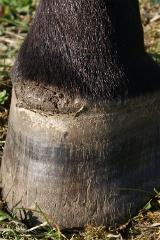Navicular Syndrome: Information and New Treatment Option

When a horse presents with chronic, intermittent forelimb lameness and pain that originates in the hoof, it is likely that the diagnosis will be navicular syndrome.
Equine Navicular Syndrome
Responsible for nearly one-third of all cases of chronic foreleg lameness, equine navicular syndrome involves the:
- Navicular bone
- Soft tissue structures that surround the navicular bone:
- Collateral suspensory ligaments
- Distal sesamoidean impar ligament
- Navicular bursa
- Deep digital flexor tendon
Cause and Damage
While the exact mechanism of injury is unknown, it is thought that the damage to the navicular bone involves biomechanical influences that:
- Increase the tension on the deep digital flexor tendon, that in turn creates
- Increased pressure across the navicular bone
The integrity of the navicular bone may be altered when the biomechanical influences are excessive. Damage caused by the continual pressure and stress may arise through:
- Changes in bone metabolism
- Increased rates of bone remodeling
Treatment
In the past, the treatment of horses suffering from navicular syndrome has focused on methods such as:
- Therapeutic hoof trimming
- Corrective shoeing
- Regenerative medicine
- Pain management
- Nutraceuticals
- Surgery
- Shockwave therapy
However, now veterinarians have one other available option. For nearly 40 years a class of drugs has been used to benefit humans in the treatment of various diseases of abnormal metabolism by inhibiting bone resorption. Research and extensive study has determined that through its ability to decrease excessive bone remodeling, the drug class bisphosphonate is applicable to the treatment of equine navicular syndrome.
Bisphosphonate
An injectable bisphosphonate solution is now available for use by veterinarians. Clodronate, the active bisphosphonate ingredient, works to decrease the breakdown of bone by:
- Inhibiting bone resorption
- Inhibiting the formation and dissolution of calcium crystals in the bone matrix
Clinical Study
The history of the disease shows that navicular syndrome is most commonly found in horses that are:
- Between 4 to 15 years of age
- Of the following breeds:
- Quarter Horse
- Thoroughbred
- Appaloosa
- Paint
- Warmblood
The clinical study focused on animals that fit conditions including:
- Between 4 to 22 years of age
- 807-1322 pounds
- 49% Quarter Horse, remaining 51% of various breeds but mainly Warmblood
The basic criteria for the study’s inclusion of specific animals focused on those:
- Diagnosed with clinical signs of navicular syndrome
- Determined absent from other causes of lameness, which was concluded through radiographics
At the start of the study the animals were evaluated and assigned a lameness score based on the American Association of Equine Practitioners (AAEP) Lameness Scale. The definition of treatment success was based on the improvement of lameness by at least one grade of the AAEP Lameness Scale.
The first phase of the study ended on Day 28 with findings that determined:
- Horses treated with bisphosphonate solution, 67.4% success rate
- Control group horses, 20.7% success rate
The second phase of the study ended on Day 56 with findings that determined:
- Horses treated with bisphosphonate solution, 74.7% success rate
- Control group horses, 3.3% success rate
The final lameness evaluation was completed on Day 180 with findings that determined:
- Horses treated with bisphosphonate solution, 65.4% success rate
- Control group horses, none evaluable
The study findings concluded that the bisphosphonate solution effectively demonstrated control of the clinical signs of navicular syndrome in horses, and supports the use by veterinarians when administered following prescribed instructions.
TO NOTE:
The Federal Drug Administration (FDA) has approved the use of Clodronate, the active bisphosphonate ingredient, in OSPHOS® to control the clinical signs associated with equine navicular syndrome. OSPHOS® is available in a ready-to-use injection, and is the only intramuscular option available for veterinary use.
Please attend the free webinar Bisphosphonates and the Control of Clinical Signs Associated with Equine Navicular Syndrome on December 3, 2015 from 2:00-3:00 PM EST. Webinar attendees are eligible to earn 1.0 hour CE credit. Register online now: http://bit.ly/decbis-b
Information gathered from:
http://www.dechra-us.com/files//dechraUSA/downloads/Client%20Literature/Osphos_client_brochure.pdf
http://www.aaep.org/info/horse-health?ppublication=83


Working Here
Our team members are encouraged to be the best they can be... at Covetrus we believe we impact one another.
Learn MoreNews & Events
FDA Cautions Pet Owners Not to Feed Texas Tripe Inc. Raw Pet Food Due to Salmonella, Listeria Monocytogenes
The U.S. Food and Drug Administration is cautioning pet owners not to feed their pets any of the Texas Tripe brand raw frozen pet food listed below because several samples of Texas Tripe raw pet food have tested positive for Salmonella and/or L. mono.
Careers
Are you looking for a place to let your talents shine? At Covetrus, we help our practitioner customers better serve their patients and take pride in providing the best customer experience possible. Search our open positions to see our available opportunities.
Newsletter
Stay current with what’s going on with Covetrus, subscribe to receive our newsletter and email communications. Subscribers will receive the latest information in practice management, sales and marketing, animal health, and more.



-3-(1).png?sfvrsn=2d806d73_0)

Leave a comment